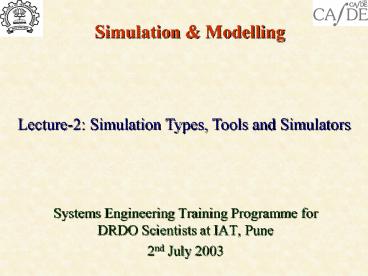Simulation - PowerPoint PPT Presentation
1 / 16
Title: Simulation
1
Simulation Modelling
Lecture-2 Simulation Types, Tools and Simulators
- Systems Engineering Training Programme for DRDO
Scientists at IAT, Pune - 2nd July 2003
2
Lecture Outline
- Software Simulation Languages
- Concept of a Simulator.
- Engineering Simulators.
- Basic Philosophy of Simulator Building
- Examples of Software Simulators.
- Examples of Hardware Based Simulators.
3
Why Software Simulation?
- Software simulation is usually a low cost, quick
turn-around time option for most of the design
cycles. - Ability to solve complex mathematical equations
(e.g. CFD) enhances the utility of software
simulation to the design development process. - Availability of fast and powerful digital
computers have rendered software simulation quite
popular. - Pure software simulations can come fairly close
to real system, as an aid in crucial decision
making.
4
What is Software Simulation?
- Software simulation pertains to solution of a
purely mathematical model. - Software simulation generates system response to
inputs, without actual product realization. - In involves writing a program that is executed on
a computer, to create the real situation. - Software simulations can be both Offline as
well as real-time simulation.
5
Software Simulation Tools
- Software simulation is carried out by programming
a digital computer suitably. - Programming is usually carried out in a higher
level language, either general purpose or special
purpose. - Extensive graphic support is needed to set up a
software simulation. - Operating System also plays an important role in
setting up a software simulation.
6
Software Simulation Languages
- General purpose simulation languages are usually
not designed for specific needs of simulation. - FORTRAN, C, C etc. are examples of such general
purpose languages which can be used for setting
up a software simulation. - These are designed for many different
applications and programming effort, to create a
specific simulation, can be quite large. - However, these are highly portable across
different computer hardware, Operating System
Compiler, resulting in cost-effective simulations.
7
Software Simulation Languages
- Special purpose simulation languages are designed
keeping in mind, specific needs of simulation. - These contain a library of pre-defined macros (or
tools) which minimize overall programming
effort. - CSMP is a popular language for continuous system
simulation. - For discrete system models, GPSS, SIMLIB, ALGOL,
SIMSCRIPT II, SIMULA, etc. are used. - Non-portability is usually the main drawback for
these special purpose language, making them
costly.
8
Software Simulation Languages
- Another class of languages, called symbolic
language, also find use in setting up
simulations. - These provide a library of mathematical functions
which can be put together to create a simulation. - MATLAB is one such symbolic language that has
acquired significant popularity as a simulation
language, mainly because of programming
simplicity. - Provision of a variety of tool boxes in MATLAB
has made it applicable to a large set of Engg.
problems.
9
Software Simulation in CSMP
CSMP provides for following macros.
Y INTGRL(IC,x), Y(0) IC Y LIMIT(P1,P2,x) YSTEP(P) Y EXP(x) Y ABS(x) Y ALOG(x) Y SIN(x) Y COS(x) Y SQRT(x) Y AMAX1(x1, x2, , xn) Y AMIN1(x1, x2, , xn)
INCON Initial Conditions CONST Constant PARAM Parameter TIMER Time Interval PRINT Printing Variables PRTPLT Plotting Data TITLE Output Heading LABEL Intermediate Headings END End of Program ENDJOB Task Completion
10
Example of CSMP Code
- Suspension System - (Step Response)
TITLE SUSPENSION SYSTEM PARAM D
(5.56,16.9,39.5,56.5) X2DOT (1.0/M)(KF KX
DXDOT) XDOT INTGRL(0.0,X2DOT) X
INTGRL(0.0,XDOT) CONST M 2.0, F 1.0, K
400.0 TIMER DELT0.005, FINTIM1.5,
PRDEL0.05, OUTDEL0.05 PRINT X, XDOT,
X2DOT PRTPLT X LABEL DISPLACE. VS. TIME END STOP
M
X
K
D
F
11
Software Simulation in SIMULINK
SIMULINK provides following functional groups.
Discrete Unit Delay, Integrator, 0 Order Hold, 1st Order Hold, DTF, DSS, Dfilter, Dzero-Pole Sources Constant, Signal Generator, Step, Sine, Chirp, Clock, File, Random No.
Linear Gain, Sum, Integrator, TFunction, State-Space, Zero-Pole, Derivative, Dot Product Tool Boxes Communication, DSP, Control, Fuzzy, System ID, NNET, StateFlow, NCD
Connections In, Out, Mux, Demux, From, Goto, Data Store/Read, Memory, Enable, Trigger, Ground, Terminator, IC, Subsystem, Selector, Width Nonlinear Abs, Math, Trig., Floor, MinMax, Product, Logic, Relation, Sign, Rate Limit, Saturation, Function, . Etc.
Sinks Scope, X-Y Graph, Display, File, Stop
12
Example of SIMULINK Model
- Suspension System - (Step Response)
M
X
K
D
F
13
Simulation in FORTRAN or C
- Suspension System - (Step Response)
Main Program Data Structures Data Communication
Strategy Integration Subroutine Plotting
Subroutine
M
X
K
D
F
14
Flight Simulation
- Flight simulation pertains to solution and
visualization of controlled aircraft motion. - There are many levels at which flight simulation
is performed, depending on the need. - At the lowest end, we have Design Simulation,
which is a purely mathematical exercise. It
contains highly idealized sub-system models. - Next, is the Engineering Simulator, in which more
accurate and detailed models of many sub-systems
are available. However, no hardware is included.
15
Flight Simulation
- Iron Bird simulation is the next level of
flight simulation wherein a majority of
sub-system hardware, excepting aircraft, are
integrated with software models. - Pilot-in-Loop simulation caters for man-machine
interface development and is usually carried out
at number of stages. - In-Flight simulation is a technique used to check
out new sub-system designs (especially Control
Laws) on an existing proven aircraft. - Ground based Real Time Simulation, on a motion
platform, is closest to Flight Simulation .
16
Summary of Software Simulation
- Software simulation is a design tool that needs
to be configured based on specific needs. - Computer, Operating System and Languages play an
important role in software based simulations. - Simulator is the system that is capable of
performing simulations as per the need. - Next part of lecture deals with simulator related
issues.































